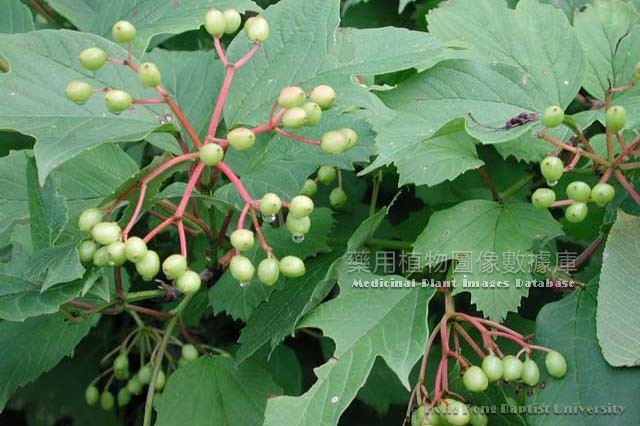|
Ampelopsis sinica (Miq.) W. T. Wang

|
English Name |
Chinese Ampelopsis, China Snakegrape |
|
Latin name |
Ampelopsis sinica (Miq.) W. T. Wang |
|
Family & Genus |
Vitaceae, Ampelopsis |
|
Description |
Vines. Stem with lenticels; young branches reddish brown short hairs, dendrils alternate with leaves, 2 bifurcated branches. Single leaves alternate; petioles 1-4.5cm long, reddish brown short hairs; leaves cordate or cordate-ovate, 5-12cm long, 5-8cm wide, top non-dividing or without prominent 3 lobes, lateral lobes small, apex blunt, base cordate, above green, below pale green, reddish brown short hairs on both sides, margin with shallow round teeth with small cusps; base out veins 5, lateral veins 4 pairs, netted veins slightly prominent at back. Flowers bisexual, dichasium alternate with leaves, 2-6cm long, reddish brown short hairs, common pedicels 1-3cm long; flowers white-green, with ca. 2mm long pedicels, base with bracteoles; calyx discoidal, 5 lobed, lobes pubescent; petals 5, distinct, outside pubescent; stamens 5, alternate with petals; ovary flatly spherical, wrapped by cup-shape flower disc. Berry spherical, green when young, blue-purple upon maturation, diameter ca. 8mm. Flowering: June, fruiting: July to October. |
|
Distribution |
Growing in thin forests of valleys and thickets at altitude 300-1,200m. Distributed in South-central and Southwest China, Jiangsu, Anhui, Zhejiang, Jiangxi, Fujian, Taiwan and etc. |
|
Part Used |
Medical part: cauline leaves and roots. Chinese name: cauline leaves: Sheputao. Root: Sheputaogen. |
|
Harvest & Processing |
Cauline leaves: harvested in summer and autumn, washed, used fresh or sun-dried. Roots: excavated root in autumn, washed, sliced or stripped the root barks, sliced, sun-dried. Picked at any time for used fresh. |
|
Chemistry |
Roots contain β-sitosterol, dancosterol, catechin), (24S)-3β-hydroxy-5-stigmast-5-ene], gallic acid, lupeol, sucrose and palmitic acid, etc. |
|
Pharmacology |
Anti-bacteria, diuresis and hemostatic. |
|
Properties & Actions |
Stem leaves: bitter, cool. Root: pungent, bitter, cool.Cauline leaves: clearing heat and inducing urination, removing blood stasis, arresting bleeding and detoxifying. Root: clearing heat and detoxifying, dispelling wind and removing damp and activating blood circulation. |
|
Indications & Usage |
Stem leaves: edema due to nephritis, difficulty in urination, Rheumatic arthralgia, falls and bruises, internal and external hemorrhage, sores. Root: pulmonary abscess and pyemesis, tuberculous empsyxis, Rheumatic arthralgia, injuries from falls, anthracia and sores, scrofula and cancerous swelling.Cauline leaves: oral administration: decocting, 15-30g, double dosages for fresh products; or immersed by wine. External: appropriate amount, triturated for application; powdered, washed in boiled water. Root: oral administration: decocting, 15-30g, double dosages for fresh products. External: decocting, 15-30g, double quantities for fresh products, smashed or ground into powder for application. |
|
Examples |
1. Epilepsy: fresh thick stem of amur grape (remove coarse peel) 90g, decoct in water and swallow, 1 time a day.
2. Traumatic hemorrhage: leaves of Chinese ampelopsis, bake until dry, grind into a powder and cast onto lesions.
3. Empsyxis: root of Chinese ampelopsis 30g, decoct in water and swallow.
4. Fracture: after bone knitting, take fresh root peel of Chinese ampelopsis, add distiller's grains or glutinous rice, an appropriate volume of distilled liquor, pestle and smear externally. |
|

